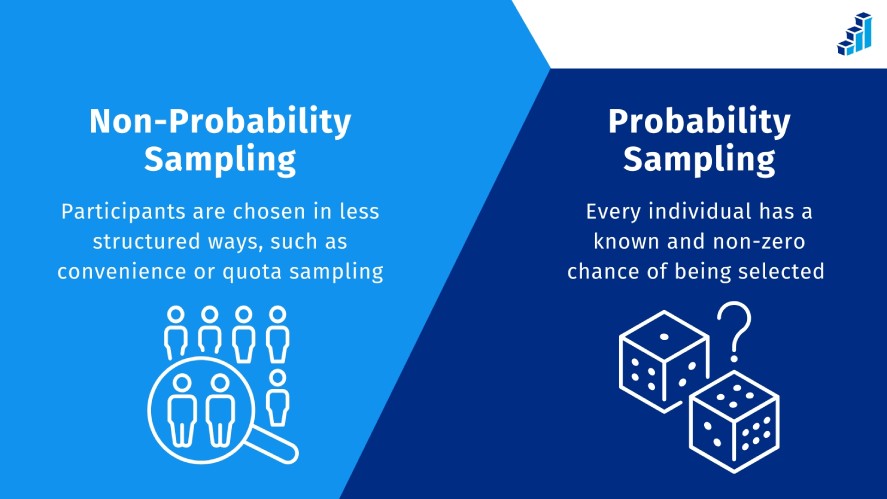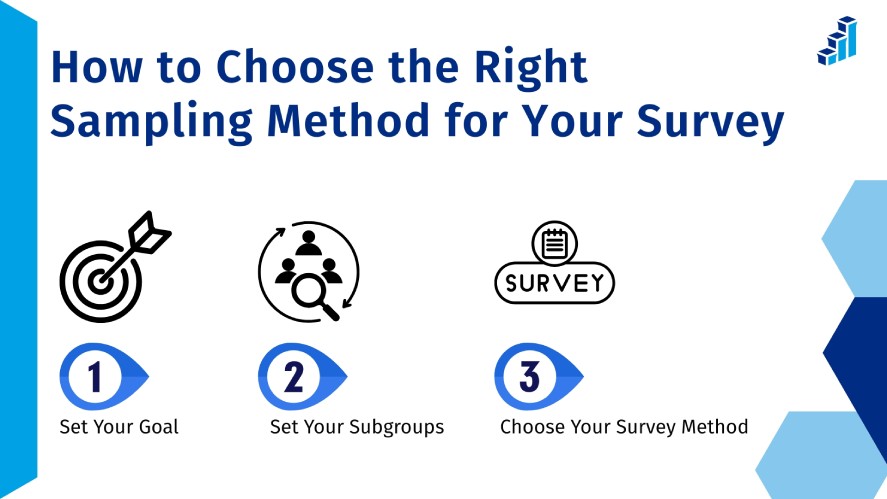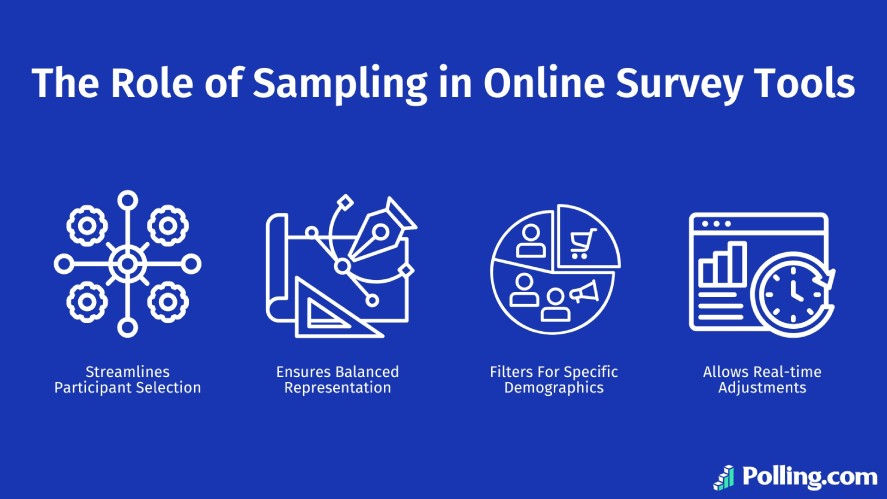
Sampling Types and Techniques: Strategies for Effective Surveys and Polls
Every good survey starts with one important step: deciding who to ask.
That’s what sampling in survey research is all about: choosing a smaller group of people to represent a larger population.
The sampling types and techniques you use to pick that group has a huge impact on whether your results are trustworthy or misleading.
In polling, sampling is the difference between accuracy and guesswork. A strong sample gives you reliable insights, while a weak one can skew the story entirely.
Think of election forecasts or market research polls: the conclusions people read in the news often come down to how carefully the sample was built.
At Polling.com, we put extra care into sampling by giving users tools that make it easier to reach the right mix of respondents.
With the right techniques, surveys don’t just produce numbers; they reflect the bigger picture with confidence.
Understanding Sampling in the Context of Polling
When running a survey, one of the first choices is deciding whether to ask everyone or just a portion of the population.
The entire group you want to study is called the population, while the smaller group you actually collect data from is the sample.
Working with a sample saves both time and money while still giving you valuable insights, assume if the sample is chosen carefully.
The main purpose of sampling is to make sure the insights you gain from a smaller group can be trusted to reflect the larger population.
The right sampling technique can reduce bias, improve accuracy, and help researchers focus their efforts on the people who matter most for the study.
There are two main categories of sampling that pollsters use:
- Probability Sampling: Every individual has a known and non-zero chance of being selected. This makes the results more statistically valid and is the focus of this article.
- Non-Probability Sampling: Participants are chosen in less structured ways, such as convenience or quota sampling. While easier, these non-probability sampling techniques risk more bias and are less reliable for generalizing results.

By understanding these approaches, you’ll see how survey designers decide who gets asked and why it matters for the accuracy of the findings.
Core Probability Sampling Types and Techniques
When accuracy matters, probability sampling methods are the gold standard.
These methods make sure every person in the population has a fair chance of being included, which reduces bias and builds confidence in the results.
Below are the most common approaches you’ll see in modern survey work and how they’re applied in practice.
Simple Random Sampling in Surveys
So, what is simple sampling?
Simple random sampling is the most straightforward approach: every individual has an equal chance of being chosen.
It works best when a complete respondent list is available, such as an employee directory or a customer database.
For instance, a company might randomly select 200 customers from its CRM to run a Net Promoter Score (NPS) survey.
Polling.com streamlines this process by automating random draws with built-in logic, eliminating the manual effort.
Systematic Sampling in Research Panels
Systematic sampling provides a structured way to select respondents when full randomization is logistically harder.
Instead of picking at random, researchers select individuals at fixed intervals, such as every 20th name on a voter registry.
This method is particularly effective for large, consistent lists like subscriber databases, where it balances efficiency with representative reach.
Stratified Sampling in Demographic Polls
So, what is stratified sampling?
Stratified sampling comes into play when specific subgroups need to be accurately represented.
In political polling, for example, populations may be divided by age, gender, or income before samples are drawn from each group.
This ensures that smaller or underrepresented voices aren’t lost in the data.
Polling.com uses stratified sampling to make sure results reflect the full spectrum of a target population rather than just its majority segments.
Cluster Sampling in Large-Scale Field Surveys
Cluster sampling is often the method of choice for surveys covering large or dispersed populations.
Instead of selecting individuals across the map, researchers choose entire groups, or clusters, such as neighborhoods, and survey within them.
This is commonly applied in door-to-door public health studies.
While it is more cost-effective and practical, it typically requires a larger sample size to maintain accuracy.
Multistage Sampling
For especially large or layered studies, multistage sampling combines several techniques.
National surveys or census projects often begin by selecting broad regions, then narrowing down to households, and finally to individuals within those households.
This staged approach provides both scalability and flexibility, making it well-suited to complex, multi-level populations.
How to Choose the Right Sampling Method for Your Survey
Not every survey calls for the same approach, which is why choosing the right sampling method is so important.
Start by asking a few key questions:
- Do you have access to a complete list of respondents?
- Are certain subgroups, like gender, location, or income, critical to your research goals?
- And what kind of survey are you running: an online panel, a field study, or a targeted poll?

The answers to these questions will often guide your choice.
For instance, if you have a clean list of participants, simple random or systematic sampling might be best.
If representation across different demographics matters, stratified sampling ensures balance.
And for large-scale projects spread across wide geographies, cluster or even multistage sampling may be the most practical.
Polling.com makes this process easier with built-in audience filters, helping you align your sampling approach with your survey objectives.
Sampling Types and Techniques in Action
To see how these techniques work in practice, consider three common scenarios.
In political polling, stratified sampling is widely used to reflect diversity across states, age groups, and party affiliations.
By doing so, pollsters can capture more accurate snapshots of voter sentiment and forecast election outcomes with greater confidence.
In customer experience research, businesses often turn to simple random sampling.
For example, a company might select 1,000 recent buyers to complete a Net Promoter Score (NPS) survey.
This randomization helps ensure that results aren’t skewed toward only the most satisfied or most dissatisfied customers, providing a fair view of overall performance.
Healthcare studies, especially those conducted across rural or remote areas, often rely on cluster sampling.
Instead of attempting to survey individuals spread across wide regions, researchers select clinics or communities as clusters, then survey patients within them.
This approach reduces cost and time, while still offering valuable insights into public health trends.
Comparison of Sampling Techniques
Before we look at the table, it helps to recap the main sampling types in research and how they’re applied.
In survey research, what is sampling if not the process of taking a smaller group to represent the whole?
These statistics sampling types each have strengths and trade-offs, which is why pollsters often explain sampling types with examples to make the concepts clear.
For instance, researchers might define simple sampling as giving every individual an equal chance to be chosen.
Political polls often use examples of stratified sampling to balance age or income groups.
A systematic sampling example could be selecting every 10th person from a contact list, which explains what is systematic sampling in practice.
When working with large areas, many studies turn to clusters. But what is cluster sampling compared to stratified methods?
That’s where the common discussion of cluster sampling and stratified sampling comes in, often framed as cluster sampling vs stratified sampling in research guides.
| Method | Best Use Case | Strengths | Weaknesses |
|---|---|---|---|
| Simple | General customer surveys | Easy to understand & unbiased | Not ideal for subgroups |
| Systematic | Ordered contact lists | Efficient & fast | Prone to hidden pattern bias |
| Stratified | Political/demographic surveys | Ensures group representation | Complex setup |
| Cluster | Geographic studies | Logistically practical | Higher sampling error |
| Multistage | National surveys & polls | Highly scalable | More resource-intensive |
The Role of Sampling in Online Survey Tools
Doing surveys by hand used to be slow and messy. You had to pick people from long lists, hope you got a fair mix, and then check everything twice.
Now, most of that work is built right into online survey platforms.
These tools don’t just collect answers. They help you reach the right mix of people.

For example, if you want younger and older groups to be equally represented, the tool can balance that for you. If you just need a random group, it can pick names automatically without bias.
Polling.com adds even more control. You can set filters based on age, location, or other traits, and the system handles the rest.
If something looks unbalanced while the survey is running, you can adjust on the fly. That way, your final results are more reliable without extra hassle.
The tool handles the heavy lifting so you can spend more time looking at the results, not worrying about whether your sample was fair.
Precision Sampling Types and Techniques Power Better Polling
At the end of the day, every good survey comes down to the sample. The way you choose people shapes the accuracy of your results and how much you can trust the insights.
Pick the right sampling types and techniques and you’ll get data that truly reflects your audience. Pick the wrong one and even the best survey questions won’t save the outcome.
With tools like Polling.com, you can take the guesswork out of sampling and focus on turning responses into smarter decisions.
